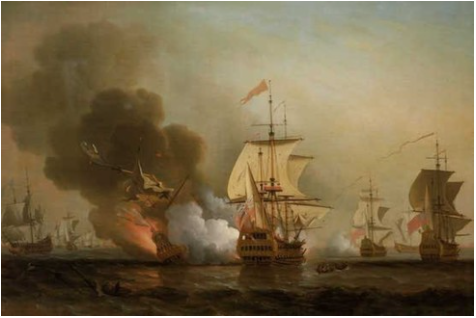The San José, with its twin and companion until its end, the San Joaquín, was commissioned by the government of Carlos II in 1696, at the Usúrbil shipyard, near San Sebastián, both ships being delivered two years later with the mission of guarding the Fleets of the Indies. Its armament, somewhat weak for the time and for its size, was about 60-62 cannons, the largest with 18 pound bullets, the rest with 10 and 6 pound bullets, more designed to confront corsairs than regular ships.
Both ships went to Cádiz and, during the War of the Spanish Succession, contributed to the defense of the port and the square against the attack and landing of the Anglo-Dutch squadron of Admiral Rooke, distinguished in victory by the already old sailor D. José Fernández de Santillán, who received the county of Casa-Alegre for his services. He also retained command of the Tierra Firme Fleet.
Before the domination of the sea by the enemy, the annual trip of the Fleet was delayed, until a relative calm allowed its departure in 1707, with the two ships mentioned, arriving without incident. The return was slower, since it had to converge in Panama, at the Portobelo fairs, with the goods brought by the South Sea Fleet, from El Callao, which crossed the isthmus by land.
The British soon found out, and to intercept that valuable convoy, they sent Commodore Charles Wager, at the head of a squadron made up of the Expedition ships, flagship and 74 guns, Kingston, 60, and the smaller Portland, 50 , as well as the frigate Severn, 44, and a fireship or incendiary vessel, the Vulture, with eight guns. The English flagship was much more powerful than the Spanish, with its 24-pounders compared to the Spanish’s 18-pounders.
Apart from bureaucratic problems and commercial operations, the Spanish chief was concerned about the poor condition of his ships, making the San José quite a bit watery, so he decided to call at Cartagena de Indias for repairs, before boarding the long and always difficult return. Finally, the Portobelo Fleet left, but with few and bad winds, which forced it to anchor off the islands of Baru, near Cartagena, at dusk on June 8, 1708.
The Spanish fleet, much smaller than in other times, formed the two ships mentioned, the San José being the captain or flagship and the San Joaquín the second-in-command, D. Miguel Agustín de Villanueva. Yet another, the Almudena, had to remain in port due to breakdowns, and was replaced by a private ship, the Santa Cruz, with 44 cannons, and the merchant urca Concepción, with only 24 cannons. The rest were light units, the pataches of the time, not suitable for serious combat, and 11 merchants, incapable of it.
The British attack was immediate, the Expedition battling the San José at less than 60 meters for more than an hour and a half, until with the fall of the shadows, the Spanish ship exploded when its Santabárbara burst for one reason or another. sinking immediately, so that of its almost 600 crew members and passengers, between 5 and 11 people were saved, according to the different accounts of the time.
Faced with that disaster, the already very inferior Spanish ships had to beat a retreat, the Santa Cruz being captured, under the command of D. Nicolás de la Rosa, Count of Vega Florida, after a heroic resistance that lasted until four in the morning, fighting alone against three enemies, and getting lost stranded when the urca Concepción fled, although its occupants were able to save themselves, who burned the hull to prevent it from being looted. The next morning, the San Joaquín regrouped the 11 merchant ships and, after disarming one of her pursuers and wisely using the knowledge of the coastal depths, they managed to save themselves from her by entering Cartagena.
The British were disappointed despite their triumph, because the San José sank with all its cargo and the San Joaquín managed to escape, and it was customary for gold and silver to be shipped precisely on warships, for greater security and control, so the booty on the Santa Cruz, the only one captured, was very modest.
The Admiralty removed the captains of the two smaller ships, Bridges and Windsor, from the service for their poor performance in combat. He nonetheless promoted Wager to Rear Admiral, who thus began a promotion that would ultimately lead him to First Lord of the Admiralty. He had previously participated in the taking of Gibraltar in that same war, in the combat of Vélez Málaga (where Blas de Lezo, still a midshipman, was wounded) and in the taking of Barcelona, until then loyal to Felipe V.
This was the tragic battle that gave rise to the current lawsuit over ownership of the treasure that houses the wreck.
Agustín R. Rodríguez González is a doctor in History and corresponding academician of the Royal Academy of History. He is the author of 39 books on naval history.
A court in Barranquilla yesterday ordered the seizure or “sequestration” of the ‘San José’ treasure, a ruling that responds to the appeal made by a United States company that claims the rights to 50% of the cargo. In this way, it maintains “the precautionary measure of kidnapping decreed in 1994.”
Conforms to The Trust Project criteria
















